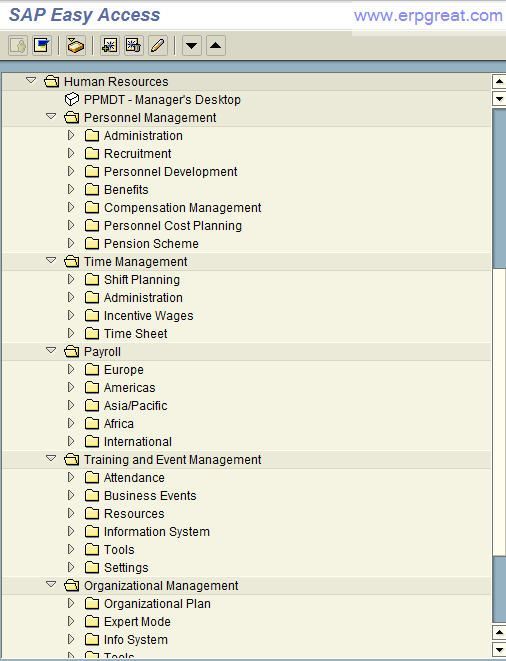Summary
The SAP Human Resource (HR) module, also known as SAP Human Capital Management (HCM), enables organizations to efficiently manage employee-related data according to specific business requirements. This powerful module leverages a structured system called Infotypes—groups of related data records identifiable by a four-digit numerical code (e.g., Infotype Addresses (0006)).Infotypes allow companies to store and process data in a time-dependent manner, enabling retroactive evaluations of employee data. Users interact with Infotypes through an entry screen that supports both individual processing and fast entry mode.
The SAP HR module is designed to streamline human resource processes, enhance productivity, and improve data accuracy across various HR functions.
What are the Main Modules of SAP HR?
The SAP Human Capital Management (HCM) module is divided into three primary scenarios:1. Workforce Process Management
This module focuses on managing employee-related processes effectively. It includes:- Employee Administration: Handling employee data, personal information, and employment history.
- Personnel Time Management and Evaluation: Managing employee attendance, absence, leave, and working hours.
- Organizational Management (OM): Structuring the organization's hierarchy, departments, and reporting relationships.
- Benefits Management: Administering employee benefits like insurance, retirement plans, and perks.
- Payroll Calculation: Processing employee salaries, deductions, taxes, and related financial transactions.
2. Talent Management
This module covers all aspects of managing employee talent and development. It includes:- Recruiting: Streamlining the hiring process and managing applicant data.
- Career Management: Defining career paths and managing employee progression.
- Succession Management: Planning for leadership and critical role replacements.
- Enterprise Learning: Providing training and educational programs to enhance skills.
- Employee Performance Management: Evaluating employee performance through standardized metrics.
- Compensation Management: Administering salaries, bonuses, and incentives effectively.
3. HR Service Delivery
This module ensures seamless interaction between HR services and employees, enhancing overall service quality. It includes:- Employee and Manager Self-Services (ESS/MSS): Allowing employees and managers to access HR-related functions independently.
- Shared Services Framework: Centralizing HR operations for improved efficiency.
How Does the SAP Human Resource Menu Look?
The SAP Human Resource Menu is designed to be user-friendly and organized by functional areas such as Personnel Administration (PA), Organizational Management (OM), Payroll, Time Management, and Talent Management. Each area is represented by modules and sub-modules accessible via the SAP Easy Access menu.
Comparing SAP HR Market with Other Modules (FI/CO)
The SAP HR market is as robust and vast as the FI/CO (Financial Accounting and Controlling) modules. Since every organization requires both financial accounting and human resource management, the demand for SAP HR professionals remains high across various industries, regions, and company sizes.Currently, the SAP HR module enjoys a strong market position, especially in areas like Personnel Administration (PA), Organizational Management (OM), and Payroll. Specialized skills in Payroll are particularly valuable due to its complexity and integration with other components like PA, OM, and Personnel Development (PD).
Tip: If you are planning to build a career in SAP HCM, focusing on Payroll can be a strategic decision due to its high demand and challenging nature. Alternatively, mastering Reporting across all components can provide a comprehensive understanding of the module.
How Long Does It Take to Learn SAP HR and Secure a Job?
The timeline for learning SAP HR and applying for relevant jobs depends on your learning approach and specialization. Generally:- Training Period: Completing SAP HR training usually takes around 3 to 6 months depending on the course and learning pace.
- Trainee Job: Gaining hands-on experience by working on a full implementation project, which typically spans around 1 year.
- Specialization: Depending on your chosen area of expertise (Payroll, Time Management, Benefits, Talent Management, etc.), you can apply for jobs in your specialization after completing your training and implementation experience.
FAQs About SAP HR Module
1. What is the difference between SAP HR and SAP HCM?
SAP HR refers to the traditional Human Resource module within SAP, while SAP HCM (Human Capital Management) encompasses a broader scope, including Talent Management, Payroll, and Workforce Process Management.2. Why is Payroll a critical area within SAP HR?
Payroll is complex due to its dependence on various other modules such as Personnel Administration, Time Management, and Benefits Management. Accurate payroll processing is essential for legal compliance and employee satisfaction.3. What are Infotypes in SAP HR?
Infotypes are data structures that group related HR information, such as employee addresses, payroll data, or personal details. They can be processed individually or in batches, allowing streamlined HR operations.4. What skills are needed to learn SAP HR?
Key skills include knowledge of HR processes, familiarity with SAP navigation, expertise in specific modules like Payroll or Organizational Management, and reporting skills.5. Is SAP HR still relevant?
Yes, SAP HR (HCM) remains a critical module for businesses worldwide due to its comprehensive capabilities in managing employee data, payroll, talent management, and organizational structures.6. What are the future trends in SAP HR?
Future trends include cloud-based HR solutions, AI-driven analytics, enhanced reporting features, and greater integration with other SAP modules.Conclusion
The SAP HR Module (HCM) offers a complete solution for managing human resources efficiently, covering everything from workforce process management to talent acquisition and payroll. With the growing demand for skilled SAP HR professionals, specializing in areas like Payroll or Reporting can significantly boost career opportunities.Also read; SAP HR Interview Questions